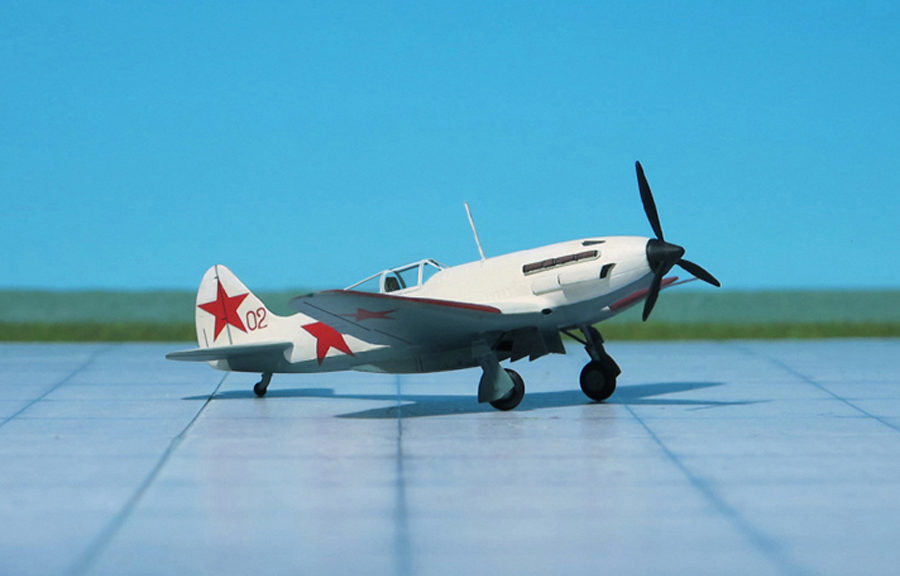TYPE: Fighter and interceptor aircraft
ACCOMMODATION: Pilot only
POWER PLANT: One Mikulin AM-35A liquid-cooled engine, rated at 1,332 hp
PERFORMANCE: 314 mph at 25,590 ft
COMMENT: The Mikoyan-Gurevich MiG-3 was a Soviet fighter and interceptor aircraft used during World War II. It was a development of the Mikoyan-Gurevich MiG-1 by the Experimental Design Department of Factory No. 1 to remedy problems found during the MiG-1’s development and operations. It replaced the MiG-1 on the production line at Factory No. 1 on December 1940 and was built in large numbers during 1941 before Factory No. 1 was converted to build the Ilyushin Il-2.
The large number of defects noted during flight testing of the MiG-1 forced Mikoyan and Gurevich to make a number of modifications to the design. Testing was done on a full-size aircraft in the T-1 wind tunnel belonging to the Central Aero and Hydrodynamics Institute (TsAGI) to evaluate the problems and their proposed solutions. The first aircraft to see all of these changes applied was the fourth prototype of the I-200. It first flew on 29 October 1940 and was approved for production after passing its State acceptance trials. The first MiG-3, as the improved aircraft was named on December 1940, was completed same month and another 20 were delivered by the end of the year.
Changes included: the engine was moved forward, outer wing panel dihedral was increased by one degree to increase lateral stability, the back of the pilot’s seat was armored with an 8 mm plate (increased to 9 mm in later models, the supercharger intakes were streamlined, the main landing gear was strengthened and the size of the main wheels was increased and the canopy glazing was extended aft to improve the view to the rear which allowed for the installation of a shelf behind the pilot for an RSI-1 radio (later upgraded to an RSI-4)
Despite the teething problems with the MiG-3, a number of reports had been received about poor quality aircraft received by the regiments which pointed directly at the NII VVS (Naoochno-Issledovatel’skiy Institoot Voyenno-Vozdooshnykh Seel—Air Force Scientific Test Institute) as it was responsible for monitoring the quality of the aircraft delivered to the VVS (Soviet Air Force). After elimination of most problems the production started and 3,422 aircraft were built in different factories spread over the eastern parts of Soviet Union.
The MiG-3’s top speed of 398 mph at 23,622 ft was faster than the 382 mph of the German Messerschmitt Bf 109F-2 in service at the beginning of 1941 and the British Supermarine Spitfire Mk. V’s 375 mph. At lower altitudes the MiG-3’s speed advantage disappeared as its maximum speed at sea level was only 314 mph while the Bf 109F-2 could do 320 mph. Unfortunately for the MiG-3 and its pilots, aerial combat over the Eastern front generally took place at low and medium altitudes where it had no speed advantage.
MiG-3s were delivered to frontline fighter regiments beginning in the spring of 1941 and were a handful for pilots accustomed to the lower-performance and docile Polikarpov I-152 and I-153 biplanes and the Polikarpov I-16 monoplane. It remained tricky and demanding to fly even after the extensive improvements made over the MiG-1 Many fighter regiments had not kept pace in training pilots to handle the MiG and the rapid pace of deliveries resulted in many units having more MiGs than trained pilots during the German invasion. By June 1941, 1,029 MIG-3s were on strength, but there were only 494 trained pilots. However high-altitude combat of this sort was to prove to be uncommon on the Eastern Front where most air-to-air engagements were at altitudes well below 16,000 ft. At these altitudes the MiG-3 was outclassed by the Bf 109 in all respects, and even by other new Soviet fighters such as the Yakovlev Yak-1. Furthermore, the shortage of ground-attack aircraft in 1941 forced it into that role as well, for which it was totally unsuited.
Over the winter of 1941–42 the Soviets transferred all of the remaining MiG-3s to the Soviet Naval Aviation and Soviet Air Defence Forces (PVO) so that on 1 May 1942 none were left on strength with the VVS. By May 1942, Naval Aviation had 37 MiGs on strength, while the PVO had 323 on hand on May. By June 1944, the Navy had transferred all its aircraft to the PVO, which reported only 17 on its own strength, and all of those were gone by January 1945. Undoubtedly more remained in training units and the like, but none were assigned to combat units by then (Ref.: 24).












